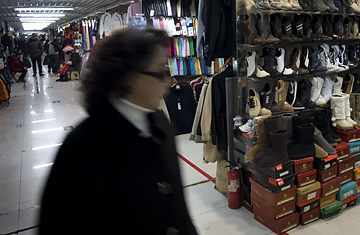
A woman walks past the stores selling variety of fashion items in Beijing. China's manufacturing shrank for a third month in December as export demand fell, suggesting an economic slump is worsening despite government efforts to shield the country from global turmoil, according to data reported Sunday.
The way in which the Chinese GDP was going to roll forward to become the No. 1 economy in the world was relatively simple. An expanding global need for cheap goods would drive a massive export machine. An expanding middle-class would become rabid consumers of items made both overseas and within China.
The system was fool-proof. Even remarkably intelligent economists and journalists talked and wrote about "the Chinese Miracle." In 2007, the nation's GDP was $3.2 trillion, but was growing at 11%. U.S. GDP was well over $14 trillion that year, but its growth rate was 3%. It was only a matter of time before the lines crossed. (See pictures of China's wild side.)
China has been able to draw upon a huge reserve of rural labor. People have moved from rural China to a number of large industrial cities in the interior of the country, many of which now have populations in the millions. Factory complexes were built in these same areas. As long as demand for output moved up, the labor forces in these regions grew. China created its own middle class which made and consumed goods at record rates.
The central government has believed that as the demand for exports softened recently due to the global recession, the country's new middle class would continue to help GDP growth through consumption.
The plan has fallen apart like a cheap watch. According to The Wall Street Journal, "China's exports in December fell 2.8% from a year earlier to $111.16 billion, while imports in the month fell 21.3% to $72.18 billion."
What was unimaginable a year ago has now happened. China has entered a recession and it may end up being deeper than the one in the U.S. It is not clear that the government can mount and manage a plan to create about 10 million new jobs. This will be an even more difficult task if exports continue to fall sharply. China does not have a service industry which is anywhere close to being as large a part of the GDP as it is in the U.S.
The illusion developed over the last decade was that China had become an independent power with a population which could make and consume goods at levels which have never been seen before. During the last two quarters, it has become clear that the the opposite is true. China's economy may be the most dependent large economy on earth.
If GDP in the U.S., E.U., and Japan contract at 5% this year, China's economy is very likely to shrink faster. It will be faced with a sharp drop in what it makes and exports. More importantly, large numbers of Chinese are leaving the huge new industrial cities and going back to rural regions where they can at least find work growing their own food. What is more than a trickle now could become a flood. Those who have gone back to non-industrialized sections of the country will not be net consumers at all.
With a short-lived and dwindling middle class, China no longer has the economic core to continue the "miracle." China has just become another big country in trouble.
—Douglas A. McIntyre
See pictures of China's electronic waste village.
For constant business updates go to 24/7wallst.com
